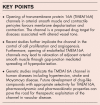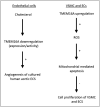The TMEM16A channel as a potential therapeutic target in vascular disease
- PMID: 38193301
- PMCID: PMC10842660
- DOI: 10.1097/MNH.0000000000000967
The TMEM16A channel as a potential therapeutic target in vascular disease
Abstract
Purpose of review: The transmembrane protein 16A (TMEM16A) Ca 2+ -activated Cl - channel constitutes a key depolarising mechanism in vascular smooth muscle and contractile pericytes, while in endothelial cells the channel is implicated in angiogenesis and in the response to vasoactive stimuli. Here, we offer a critical analysis of recent physiological investigations and consider the potential for targeting TMEM16A channels in vascular disease.
Recent findings: Genetic deletion or pharmacological inhibition of TMEM16A channels in vascular smooth muscle decreases artery tone and lowers systemic blood pressure in rodent models. Inhibition of TMEM16A channels in cerebral cortical pericytes protects against ischemia-induced tissue damage and improves microvascular blood flow in rodent stroke models. In endothelial cells, the TMEM16A channel plays varied roles including modulation of cell division and control of vessel tone through spread of hyperpolarisation to the smooth muscle cells. Genetic studies implicate TMEM16A channels in human disease including systemic and pulmonary hypertension, stroke and Moyamoya disease.
Summary: The TMEM16A channel regulates vascular function by controlling artery tone and capillary diameter as well as vessel formation and histology. Preclinical and clinical investigations are highlighting the potential for therapeutic exploitation of the channel in a range of maladaptive states of the (micro)circulation.
Copyright © 2024 The Author(s). Published by Wolters Kluwer Health, Inc.
Conflict of interest statement
Figures




References
Publication types
MeSH terms
Substances
Grants and funding
LinkOut - more resources
Full Text Sources
Medical
Research Materials

